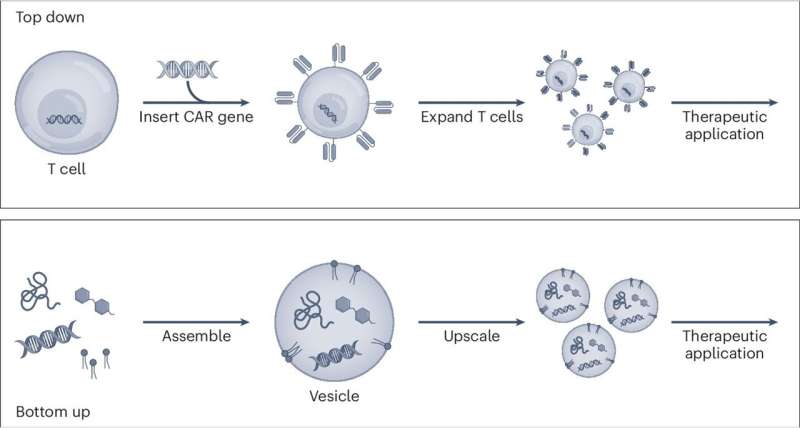This article has been reviewed according to Science X's editorial process and policies. Editors have highlighted the following attributes while ensuring the content's credibility:
fact-checked
peer-reviewed publication
trusted source
proofread
Synthetic immunology: Approaching a turning point in the treatment and prevention of disease

Synthetic immunology, an innovative field of research that could lead to fundamentally new approaches and methods in the treatment of infectious diseases and cancer, is the topic of a new article published in Nature Nanotechnology.
Heidelberg researchers Prof. Dr. Kerstin Göpfrich, Prof. Dr. Michael Platten, Prof. Dr. Friedrich Frischknecht, and Prof. Dr. Oliver T. Fackler describe a so-called bottom-up approach that uses the toolbox of nanotechnology and synthetic biology to construct systems from molecular building blocks and specifically equip them with immune functions.
The experts in the fields of synthetic biology, neuroimmunology, parasitology, and virology conduct research at Heidelberg University, the Heidelberg and Mannheim University Hospitals, the German Cancer Research Center, and the Max Planck Institute for Medical Research.
In the new bottom-up approach in synthetic immunology, complex immune functions are no longer created by modifying existing cells or molecules, but rather originate from molecular building blocks like nanoscale components or artificial cells assembled into complex systems.
The process is based on technologies and techniques from synthetic biology such as the design of proteins and peptides, polymer synthesis as well as DNA/RNA modification and DNA/RNA origami—the three-dimensional "folds" of DNA or RNA strands—to produce functional nanostructures.
As the authors discuss in their article, the new bottom-up approach in synthetic immunology will allow unparalleled precision and control in shaping immune functions. By manufacturing immune components from the ground up, immune responses can be custom-engineered with great specificity and efficiency.
This could lead to groundbreaking approaches in the development of new therapies and vaccines that circumvent the constraints of traditional approaches, such as unwanted side effects or time-limited efficacy.
The Heidelberg researchers believe that the bottom-up approach not only promises improved therapeutic approaches and methods but can also push the future boundaries of what is possible in the treatment of complex illnesses.
The further development of this research field could lead to the development of completely synthetic immune effectors that, according to the vision, could then prevent and treat diseases.
"We are facing a turning point in the treatment and prevention of infectious diseases and cancer. The synergies between synthetic biology and immunology open up a number of possibilities that could one day create a completely new basis for how we deal with disease," states Prof. Göpfrich.
More information: Kerstin Göpfrich et al, Bottom-up synthetic immunology, Nature Nanotechnology (2024). DOI: 10.1038/s41565-024-01744-9





















